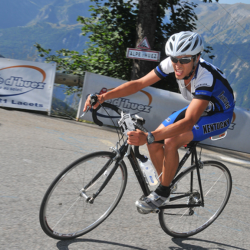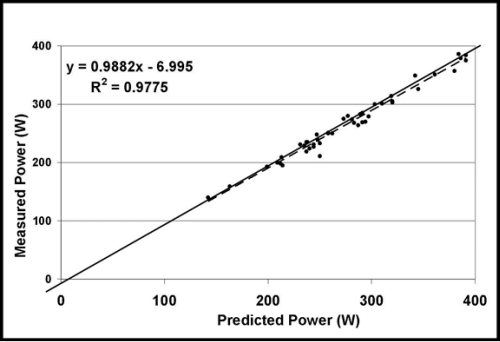
* n'at a "general extender"[2][3] (http://en.wikipedia.org/wiki/Pittsburgh_English)
For those of you not well versed in the language of “Pittsburghese”, we use the phrase “n”™at” for a variety of reasons, but in this case it means “along with some other stuff”. Consider this a “side-bar” to the story I”™ve been building in this Evidence Based Cycling blog. John Macgowan wrote an article on incorporating the “grade of a climb” into your Indoor Cycling classes, and it seemed like a great topic to write a follow up for.
Power, Speed & Grade of the Hill
While writing the first book on Training with Power for the Indoor Cycling environment, it became imperative to create a system that was both practical and easy to teach from Indoors, but that could also be directly applicable outdoors. After all, the mission of Cycling Fusion™ from day 1 has been to bring these two worlds together, and the validation of how our training translates while riding on 2 wheels continues to be a Start Trek level “Prime Directive”.
To that end, my crew and I followed the same approach I have been describing each week through this blog. . So, I purchased an outdoor power meter (the iBike was the cheapest that had about a 5% tolerance for accuracy — plenty for our application. Getting 100% accuracy is absolutely necessary indoors, since we won”™t have the same power gauges outside anyway, and we just need to know that we are improving it, not that we are at 200 or 300 or 225 or some other arbitrary power number.
When I would ride outside, I would compare the wattage I was seeing indoors with wattage figures while riding outdoors. This led to a variety of research undertakings with myself and my study participants. This work on Power truly marked the beginning of Evidence Based Cycling, I just had not put a name and more structure to it at that time.
1 Watt per Pound
One of the key principles presented in the book is the notion that if we want to ride outside, or more specifically, if we want to be able to climb typical hills that cyclists normally climb outside, we need to be able to achieve a minimum of about 1 Watt per pound of weight you are carrying up the mountain (rider wt + bike wt).
Through existing math equations, we were able to create a chart that showed how many Watts/lb would be required on hills with specific grades, given specific speeds. It turns out that under 1 Watt/lb there are few hills that can be ridden at a speed of 5 MPH or greater. Below 5 MPH it becomes increasingly hard to hold the bike upright. One can just about walk at 4mph, and that”™s not “speed walking”.
Willing Guinea Pigs… er Volunteers
I was lucky enough to have a bunch of regular members that embraced the whole EBC approach to training and learning, and they were more than willing to help with the research. We first wanted to know if the chart and our math seemed to bear itself out in the real world. We used different people, at different riding and fitness levels to climb various hills with differing grades with our power meter, and we found that the numbers seemed to jive. While the testing of our own clients and fellow coaches/instructors would have been enough for us to build our training with, in writing a book for “the masses” we were compelled to go a bit further.
We wanted to establish some early credibility with both the book and our own research, so we commissioned a University Study to validate the formula and the chart in a different state with different riders, and with a Power Tap that would directly measure power instead of our inexpensive model that only calculated it.
Independent Validation
Carl Foster, Ph.D., FACSM; is the director of the Performance Lab at the University of Wisconsin. His team independently validated the chart that our 1 Watt/Lb principle is based upon, and thus we have a solid foundation for using this as a good target Power goal for the average rider. Here are the final excerpts from their published paper:
Results: Predicted PO and measured PO (within the range of 140-400W) were highly related (r=0.989), with an essentially zero value for intercept (Figure).
Conclusions: Without correction for wind, altitude or the effect of additional riders, the relationship between predicted and measured PO during cycling was very strong, supporting the value of published climb equations.
Comparison of Predicted and Measured Power Output During Uphill Cycling
Carl Foster, Ph.D., FACSM; Jacob Cohen, Gene Nacey University of Wisconsin-La Crosse and Cycling Fusions.

Comparison of Predicted and Measured Power Output During Uphill Cycling Carl Foster, Ph.D., FACSM; Jacob Cohen, Gene Nacey University of Wisconsin-La Crosse and Cycling Fusions.
Implications for Indoor Cycling Instructors
Given that there are no real hills and real grades in an indoor cycling room, one must artificially create the feeling by adding resistance. With the spate of power indoor cycles there are now on the market, using the Speed & Power Chart, and specifically 1 Watts/Lb as a target, and the concept of Watts/Lb as a training parameter can provide a ton of useful options for cueing climbs or even entire classes.
Originally posted 2012-06-14 05:42:48.
- Me & My Big Mouth - April 18, 2024
- Indoor Cycling Power Research #7: Good News, Bad News - August 16, 2023
- Blog Post #10 Baseline& Performance Testing - June 29, 2023

Gino, there always seem to be questions about power training numbers. So I’m going to ask you to dig into your EBT, Experienced Based Teaching.
But first, My Power Training book is tattered, dog eared, book marked and stored in a fire proof safe. Great work. I wish more people understood the value.
Ok questions. Is there a 2nd edition with any new information not included in the first edition?
Not coincidentally, I’ve managed to get my self teaching at studios with indoor bikes that measure power. In one studio there are 26 the other 13. Schwinn & Keiser respectfully.
These are open classes and – I’m happy to report – are mostly full. riders cannot get the same bike every class (though they dearly try) and we don’t get the same riders every class.
So my next question is, how do you recommend dealing with calibrations issues as well as the varying numbers bike to bike in open classes? (beyond the obvious, get them calibrated)
If I were to refer my riders to your chart that calls out watts/lb for a given speed and %grade wouldn’t I need all the bikes to be calibrated precisely accurate?
If the 200 lb rider cannot get to 1/watt/lb at a reasonable resistance and cadence does that mean they’re not trained or the bike is not calibrated?
There are more but let’s start here.
Hi Chuck,
Thanks for the thoughtful comments and questions. SO… here goes…
First Answer: I have begun writing a 2nd edition, and yes, it will be chock full of new stuff – but sadly it will take a lot longer to get completed than I like – probably next winter at best.
Second Answer: I can’t give you any advice on dealing with the calibration issues between bikes because we eliminate it by offering only WORKSHOP type series, and no individual classes. We started it this summer, and will triple our offerings this fall. Essentially it amounts to pre selling a set of classes with a specific objective – like the one I’m doing this summer is Intro to Outdoor riding, where 2 times per week we ride inside, and 1 time on a closed trail like Rails to Trails.
Last Answer: If a 200 lb (or a 120 lb woman for that matter) can not get to 1/Watt/lb (at ANY resistance, (since the Watts still reflect the real work being done) it means they have not been working on leg strength. I would look to the rider much before the bike.
great read and helpful.
2 questions posed to me and now to you based on the 120lb woman that obviously needs leg strength work to see the 1//watt/lb. exact situation i had in class only slightly heavier woman that doesn’t ride outside so she’s only wanting to use this as a measurement of getting stronger and fitter.
What would be a reasonable watt/lb expectation to want to see and aim for on the indoor bike in class as someone begins power training?
How long to expect someone to initially sustain the 1/watt/lb?
I have read and heard “It depends” and not to give a specific # to a person, much like not telling someone how many gears or how many turns of resistance as every bike and rider is different of course.
With that said these people do want something to aim for and i want what i say to be correct, safe and appropriate.
Renee,
I’m sure Gino will have an appropriate answer but I can tell you that I start everybody every class (except for my regulars) at 80 RPM and what ever gear get them to 1/2 body weight rounded some how. I use nearest 10 lbs. I’ve heard Gino go with ’rounded to nearest 25. LIke I say I’m sure he’ll chime here soon.
Two things Renee; 1) I give them the option of lower cadence if 80 seems unsustainable. 2) Once they get sort of locked into 1/2 body weight I tell them if that feels way to easy add 25%.
The goal (at least in my class) is to get them a place to begin from and recover to. This is much easier on the Keiser because they do indicate gear. Still, the power number is what it is and they can repeat it even with the ‘Red’ knob on the SchwinnAC.
Hope that helps.
Renee,
I realized I didn’t fully complete the post. Once you have a starting place such as I mentioned as your riders improve they should start creeping up on that magic one watt per pound.
Chuck is right on Renee – starting at 50% of 1 Watt/lb. So if they way 200 lbs, get them to WARM UP at 100 watts – that should be doable. Then if you do a field test to arrive at their threshold Heart Rate, you can slowly but surely have them work at harder heart rates in conjunction with the power numbers increasing. Just sweating, or just raising heart rate is not enough – we need to actually be doing more WORK – which is only going to be represented well with POWER.
In respect to “how long” they should sustain 1 W/lb, I see what they can sustain for 10 minutes, once they are past the “prepare to train phase”. For someone just off the couch, that typically take 2 – 3 months. SO… once they have the highest watts they can sustain for 20 minutes, while being in ZONE 4, you have a place to work from to have them do just as Chuck recommended – 1 Watt/lb.
If they don’t ride outside, is that still the “magic number”. Well yes – simply because it’s not that ambitious – really – with training everyone should be able to manage that for 10 min at least – but it might take a YEAR or more to get there – but get there they will. With a smart and progressive training plan.
Good luck.
chuck and gino,
this is incredibly helpful and pretty much what i’ve been working from. so good to know i’ve been on the right path but glad to know how to move them forward with appropriate expectations and training time so as not to overwhelm or frustrate them.
Much appreciated.